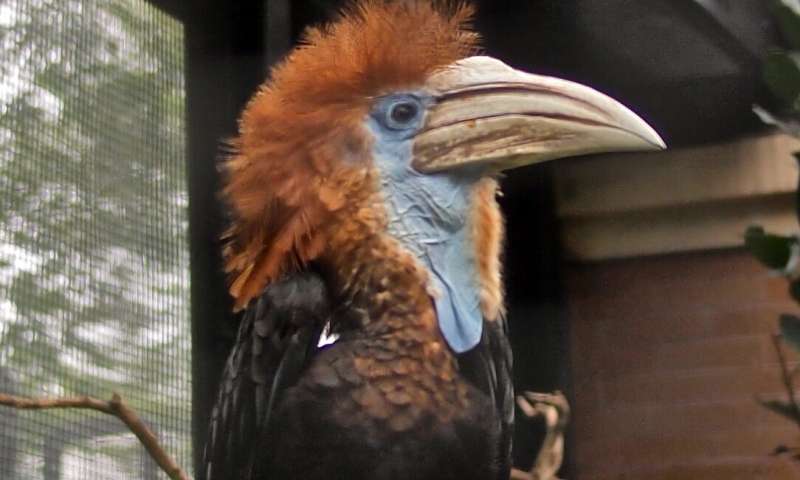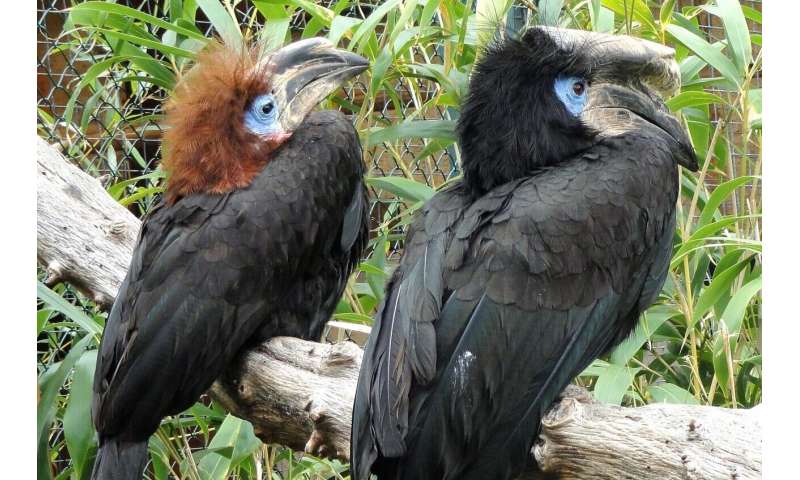
A Cameroonian hunter holds a yellow-helmeted hornbill (Ceratogymna elata), a restricted-range species classified as critically endangered by the IUCN. Image credit: Ndjounguep, CC BY-SA 4.0, via Wikimedia Commons
Tropical birds known for their enormous beaks include 32 Asian and 27 African species of the bird family Bucerotidae. Many hornbills have a helmet on their upper beak, which is spectacularly colorful in some species. Many species also have a unique breeding strategy in which breeding females incubate eggs and raise chicks for up to 100 days in sealed natural tree cavities, completely dependent on males to bring them food.
Unfortunately, due to overhunting and habitat destruction, almost half of all hornbill species are classified as critically endangered by the International Union for Conservation of Nature (IUCN). In addition, many African species that are still classified as “least concern” by the IUCN have been extirpated from large parts of their original range, for example in Nigeria and Ghana.
Now, African hornbills face a new threat: commercial demand for their heads in international trade. Cameroonian researcher Francis Guetse brought this issue to our attention after receiving reports of hornbill hunting for foreign buyers in Mont Nlonako, Cameroon, an important bird sanctuary and planned game reserve. Together, we decided to investigate the issue, taking into account both the online hornbill trade and interviews with hunters in Cameroon.
The wildlife trade has led to species declines and extinctions worldwide, and unfortunately wild birds make up a large proportion of the trade. Unsustainable hunting and trapping to supply these markets is therefore a recognised threat to many bird species such as African vultures, Asian hornbills and parrots worldwide, but the consequences for African hornbills have received little attention.
We surveyed online retailers to investigate online sales of African hornbill-related products and assessed hornbill hunting practices in western Cameroon through interviews with local residents on hornbill demand, supply and hunting pressure.
The emergence of online social media platforms has led to a rapid expansion of global wildlife product markets, spanning both legal and illegal trade. Social media platforms currently offer traders unprecedented opportunities to reach customers and bypass traditional middlemen.
In our analysis of online sales, we took into account factors such as number of sales, species protection status, listing under the Convention on International Trade in Endangered Species (CITES), and skull and body size.
-

The white-shanked hornbill (Bycanistes albotibialis) is one of three species native to Cameroon that accounted for 66% of the online trade in hornbills. Image credit: Tommy Andriollo, CC BY-SA 4.0, via Wikimedia Commons
-

The Yellow-helmeted Hornbill (Ceratogymna elata) is one of three species native to Cameroon that accounted for 66% of the online trade in hornbills. Image credit: Denise Chan, CC BY 2.0, via Wikimedia Commons
-

A pair of black-helmeted hornbills (female on the left, male on the right) in a zoo. Image credit: Daderot – Public Domain, via Wikimedia Commons
We found that online hornbill trade includes skulls and other products from five Asian species, all of which are on the CITES list, and 20 African species, representing almost 75% (20/27) of all species on the African continent. Almost half (9/20) of the African hornbill species we found in online trade were native to Cameroon, of which three species – the Yellow-helmeted Hornbill (Ceratogymna elata), the Black-helmeted Hornbill (C. atrata) and the White-thighed Hornbill (Bycanistes albotibialis) – accounted for 66% of hornbill products on the internet.
About 73% of the Cameroonian hunters surveyed specifically intended to hunt hornbills, with 91% of them seeking to acquire hornbill heads for trade. Almost all of them reported that they intended to sell their products to foreign buyers. The hunters indicated that demand for hornbill heads was driven by Asian demand, with locals considering the nationality of the buyers to be Chinese, although confirming the identity of the buyers was beyond the scope of our study.
Our research also revealed a change in hunting behaviour in Cameroon over a two-year period, with younger hunters targeting hornbills more frequently. Although Cameroonian Decree 73/658 regulates the carrying of firearms and ammunition, enforcement of forestry laws is weak and firearms are widely used by hunters in the Mont Nlonako area.
Hunters reported shooting any animal that was available for sale, and interviews revealed that many were aware that they were engaging in illegal activities that could result in legal consequences. Hunters also reported that hornbill populations appear to have declined over the past two years due to drastic population reduction, and that they are therefore venturing into other areas in search of hornbills to hunt.
African hornbills are not typically classified as luxury products such as elephant ivory and are therefore subject to fewer trade regulations. Our findings highlight the urgent need to address the negative impacts of the international wildlife trade and take action to protect African hornbill populations from the increasing threat of overexploitation.
Conservation action is particularly urgent because even where hornbill species are fully protected by law, intense persecution from the international trade in their helmets can lead to severe population declines that could push the species to the brink of extinction. While online trade in hornbill heads has shown little price variation for hornbill species from Cameroon, international demand could lead to overfishing of the hornbill species due to their visibility and value.
A striking example is the helmeted hornbill (Buceros vigil) of Southeast Asia, a species whose massive beak and helmet command prices exceeding the price of ivory by weight. Although this species is protected by law throughout its range, it has reached the brink of extinction due to intense persecution and is now critically endangered.
Hornbills are the only hornbills to have a solid (rather than hollow) helmet. Although the hollow helmets of other hornbill species are less suitable for carving, their distinctive shape and appearance still attract buyers, which puts these species at risk.
To this end, we strongly recommend that the African hornbill and other similar species be included in Appendix II of CITES, as these species are not currently threatened with extinction but may be so without trade controls.
Currently, many Asian hornbills are listed in the CITES list, but African hornbills are not. This may have led to increased trade pressure on African hornbills, as we have shown in our Global ecology and nature conservationWe hope that both Cameroonian and international authorities will take these findings into account to support conservation awareness campaigns and law enforcement actions to protect hornbills and other remarkable African wildlife.
Future research priorities include investigating foreign destinations and trade routes for Cameroonian hornbills, as well as understanding the extent to which local hornbill populations are declining in response to hunting pressure. We also call for conservation actions, including education campaigns and law enforcement, to be accompanied by ongoing efforts to monitor populations of these iconic birds.
This story is part of the Science X Dialogue, where researchers can share insights from their published research articles. On this page you will find information about the Science X Dialogue and how to participate.
Further information:
Shan Su et al., A bounty on them? Assessing foreign demand as a driver of hornbill hunting in Cameroon, Global ecology and nature conservation (2024). DOI: 10.1016/j.gecco.2024.e02905
Nico Arcilla and Shan Su work with the International Bird Conservation Partnership (IBCP), whose mission is to promote and support research, outreach and partnerships to advance bird conservation worldwide.
Quote: A bounty on them? Impacts of international trade on African hornbills in Cameroon (28 August 2024), accessed 28 August 2024 from https://phys.org/news/2024-08-price-implications-international-african-hornbills.html
This document is subject to copyright. Except for the purposes of private study or research, no part of it may be reproduced without written permission. The contents are for information purposes only.

